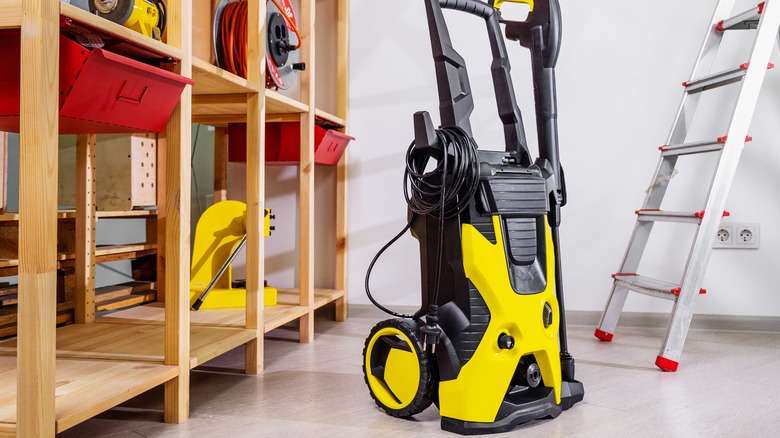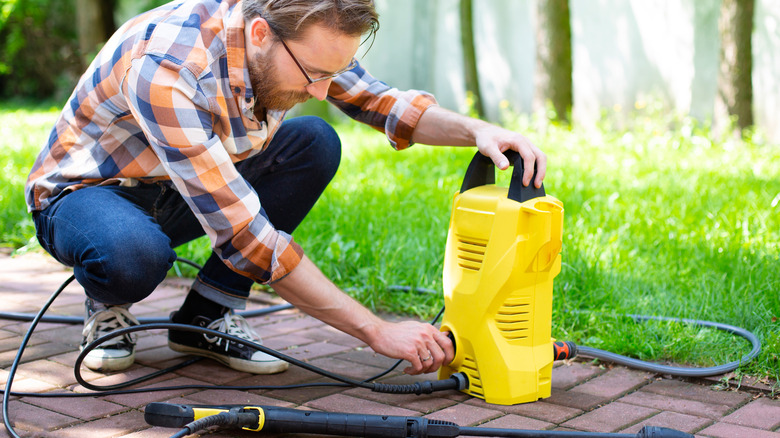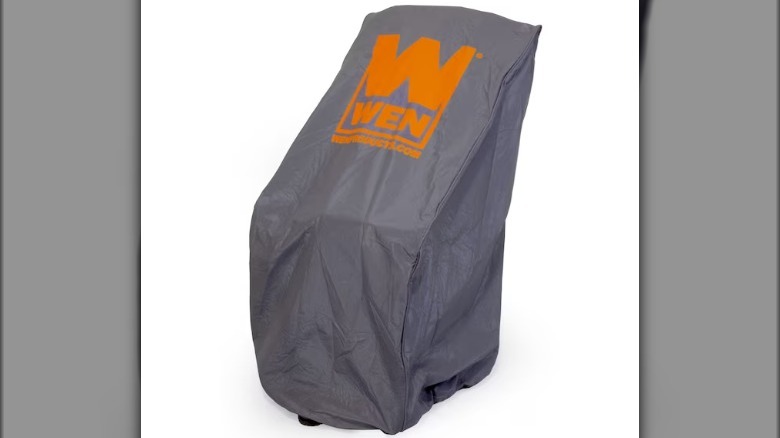How To Store Your Pressure Washer After You're Done With It
The immense satisfaction that comes from seeing the results of pressure washing makes some homeowners wonder how they ever lived without one. Simply put, the high-octane machine is a blast to use. Whether the device's explosive jets of water are erasing years' worth of dirt, grime, and algae from siding, decks, or driveways, there's no debating its effectiveness and versatility. Consequently, it's critical to properly store a pressure washer when you're not using it. Taking a little time to protect the machine's interior and exterior parts from the elements prior to stowing it will go a long way to ensuring its longevity. Most importantly, you need to remove all the liquid from the hoses and internal parts and make sure it's stored somewhere dry and free from frost.
Perhaps you are giving your pressure washer an extended rest while you are on a long vacation or you just want to pack it away for the season. Regardless, you'll want to avoid simply parking the pricey power tool in a shed or garage without accounting for long-term storage vulnerabilities, such as rust build-up, cracks, and leaks. Whether you own a gas-or-electric-powered pressure washer, it's a good idea to proactively prep your machine before hitting pause for even a few weeks as exposure to harsh conditions could lead to severe damage. Fortunately, getting a pressure washer ready for a lengthy latency is a fairly straightforward process that requires little more than inspecting and tending to the machine's pivotal parts.
Start by draining and cleaning
Begin by disconnecting the pressure washer's hoses and drain the tanks and lines of any water, detergent, or fuel. This is especially important if you live in a cold climate, as any remaining liquid could potentially freeze and cause substantial damage to your pressure washer as it sits idle. If you're particularly concerned about freezing, consider using an air compressor to expel any residual liquid from lines, hoses, and tanks. Another option is to rinse the device's pumps with a little antifreeze. Doing so will protect the engine's components from icing and breaking. In addition, if you are planning to store your pressure washer for more than 30 days, take a few minutes to change the oil before putting it away. This will not only help protect the inner workings from corrosion but will also prevent sludge from building up.
Next, focus on cleaning your pressure washer's filters and nozzles. The former requires wiping the metal mesh screen to remove residue, which if left to sit, can clump and clog the filter. The latter needs to be detached and thoroughly wiped down to eliminate any deposits that could cause corrosion while in storage. You'll also want to clean the exterior of the pressure washer with a damp cloth to remove any mud, dust, or grime that may have accumulated from previous tasks. Then, go back with a dry cloth to absorb any residual moisture on exposed surfaces which could lead to rust.
Tips for choosing the right storage location
When selecting the ideal storage location for your pressure washer consider space and temperature. To prevent damage to the exterior of your machine, avoid cramming it in an already crowded closet, shed, or garage corner. Rather, place the cleaning tool upright in a remote area free from items that could potentially fall on it and cause scratches or dents. In addition, don't stow your water pressure in a spot where rodents can chew on its wires or nest in disconnected parts. Rather, opt for a clean, dry site, and consider covering your machine with a sturdy canvas or plastic cover. This extra line of defense will not only shield it from varmints, but bugs and dust as well. If it's feasible, stash your pressure washer in a climate-controlled space. Ideally, you don't want to expose your motorized unit to extreme temperatures or inclement weather, particularly rain, snow, and ice, as moisture can wreak havoc on the machine's inner workings.
Finally, before saying goodbye to your beloved pressure washer for weeks or months, give it one more thorough examination. Pay special attention to the gun, wand, hoses, and nozzles. If you notice any cracks, tears, or holes, patch or replace them right away. Don't store a pressure washer with damaged parts, as even minor flaws can be exacerbated when left dormant for a long stretch of time.


